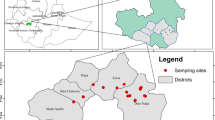Abstract
The disposal of untreated urban sewage in to open water bodies is common in most developing countries. This poses potential negative consequences to public health and agricultural sustainability. Hyderabad, one of India’s largest cities, disposes large amounts of its wastewater untreated into the Musi River, from where it is used, with the aid of irrigation weirs, for agricultural production. This paper presents a 14 month (December 2003 – January 2005) water quality survey which aimed to quantify spatial and temporal changes in key water quality parameters along a 40 km stretch of the Musi River. The survey found that river water quality improved dramatically with distance from the city; from untreated sewage in the city to irrigation water safe for use in agriculture 40 km downstream of the city. This improvement was contributed to by different treatment processes caused or aided by the irrigation weirs placed on the river.

Similar content being viewed by others
References
APHA-WWE-WEF (1998) Standard methods for the examination of water and wastewater. American Public Health Association, Washington D.C
Ayres RM, Lee DL, Mara DD, Silva SA (1993) The accumulation, distribution and viability of human parasitic nematode eggs in the sludge of a primary facultative waste stabilization pond. Trans R Soc Trop Med Hyg 87:256–258
Ayres RM, Mara DD (1996) Analysis of wastewater for use in agriculture; a laboratory manual of parasitological and bacteriological techniques. World Health Organisation, Geneva
Bhaskaran TR, Sampathkumaran MA, Sur TC, Radhakrishnan I (1956) Studies on the effect of sewage treatment processes on the survival of intestinal parasites. Ind J Med Res 44:163–180
Blumenthal UJ, Cifuentes E, Bennett S, Quigley M, Ruiz-Palacios G (2001) The risk of enteric infections associated with wastewater reuse: the effect of season and degree of storage of wastewater. Trans R Soc Trop Med Hyg 95:131–137
Buechler S, Devi G (2003) Household food security and wastewater dependent livelihood activities along the Musi-river in Andhra Pradesh, India: http://www.who.int/water_sanitation_health/wastewater/gwwufoodsecurity.pdf (Accessed, December 2005)
Delgado C, Rosegrant M, Steinfeld H, Ehui S, Courbois C (1999) Livestock to 2020: the next food revolution., International Food Policy Research Institute, Food and Agriculture Organization, International Livestock Research Institute
Ensink JHJ (2006) Wastewater quality and the risk of hookworm infection in Pakistani and Indian sewage farmers. PhD thesis, University of London
Ensink JHJ, Blumenthal UJ, Brooker S (2008) Wastewater quality and the risk of intestinal nematode infection in sewage farming in Hyderabad, India. Am J Trop Med Hyg 79(4):561–567
Feachem R, Bradley D, Garelick H, Mara DD (1983) Sanitation and disease: health aspects of excreta and wastewater management. John Wiley & Sons, Chichester
HACH (1997) Water analysis handbook. HACH company, Loveland
Hofstedt C (2005) Wastewater use in agriculture in Andhra Pradesh, India. An evaluation of irrigation water quality in reference to associated health risks. Department of soil sciences, Swedish university of agricultural sciences, Uppsala, p 61
HUDA (1994) Hyderabad master plan. Status paper, Hyderabad Urban Development Authority, Hyderabad
Juanico M, Shelef G (1991) The performance of stabilization reservoir as a function of design and operation parameters. Wat Sci Tech 23:1509–1516
Katta MR (1997) Predatory industrialisation and environmental degradation: a case study of Musi-river. Telangana: Dimensions of underdevelopment, Center for Telangana studies, Hyderabad, pp 203–212
Kumar RM (2003) Financing of wastewater treatment projects. Infrastructure development finance corporation and confederation of Indian industries. Water Summit 2003
Kurien V (2004) India’s milk revolution -Investing in rural producer organizations. The World Bank, Gujarat
Lakshminaruyana JS, Abdulappa MK (1972) The effect of sewage stabilization ponds on helminths. In: Sastry CA (ed) Low cost wastewater treatment. Central Public Health Engineering Research Institute, Nagpur
Mara D (1997) Design manual for waste stabilization ponds in India. Lagoon Technology International Ltd, Leeds
McCartney M, Scott C, Ensink J, Jiang B, Bigg T (2008) Salinity implications of wastewater irrigation in the Musi river catchment in India. Cey J Sci (Bio Sci) 37:49–59
Otaki M, Okuda A, Tajima K, Iwasaki T, Kinoshita S, Ohgaki S (2003) Inactivation differences of microorganisms by low pressure UV and pulsed xenon lamps. Wat Sci Tech 47:185–190
Panicker PVRC, Krishnamoorthi KP (1981) Parasitic egg and cyst reduction in oxidation ditchs and aerated lagoon. J Wat Poll Cont Fed 53:1413–1419
Pescod MD (1992) Wastewater treatment and use in agriculture. Food and Agricultural Organization, Rome
Rhoades JD, Kandiah A, Mashali AM (1992) The use of saline waters for crop production. Food and Agricultural Organization, Rome
Shaw E (1984) Hydrology in practice. Van Nostrand Reinhold (UK) Co. Ltd. Wokingham, 569 pp
UNPD (2003) http://esa.un.org/unup/ (Accessed July 2005)
van Rooijen DJ, Turral H, Bigg TW (2005) Sponge city: water balance of mega-city water use and wastewater use in Hyderabad. India Irrig and Drain 54:S81–S91
Venkateswarlu V (1969) An ecological study of algae of the river Moosi, Hyderabad (India) with special reference to water pollution. I. Physico-chemical complexes. Hydrobiologica 33:117–143
WHO (2006) Guidelines for the safe use of wastewater in agriculture. WHO, Geneva
Yoon CG, Kwun SK, Ham JH (2001) Effects of treated sewage irrigation on paddy rice culture and its soil. Irrig and Drain 50:227–236
Acknowledgements
Wastewater research in Hyderabad was supported from core money from the IWMI. Simon Brooker is supported by a Wellcome Trust Advanced Training Fellowship (073656).
Author information
Authors and Affiliations
Corresponding author
Rights and permissions
About this article
Cite this article
Ensink, J.H.J., Scott, C.A., Brooker, S. et al. Sewage disposal in the Musi-River, India: water quality remediation through irrigation infrastructure. Irrig Drainage Syst 24, 65–77 (2010). https://doi.org/10.1007/s10795-009-9088-4
Published:
Issue Date:
DOI: https://doi.org/10.1007/s10795-009-9088-4




